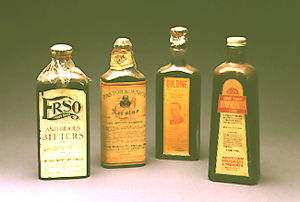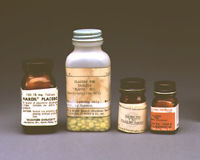Contents |
Early use of placebos
-
 Anti-bilious bitters and other early placebos
Anti-bilious bitters and other early placebos
Originally, a placebo was a substance that a well-meaning doctor would give to a patient, telling him that it was a powerful drug (e.g., a painkiller), when in fact it was nothing more than a sugar pill. Thus, Hooper's medical dictionary of 1811 says placebo is "an epithet given to any medicine adapted more to please than benefit the patient." The subsequent reduction of the patient's symptoms was attributed to the patient's belief in the drug.
Placebos are themselves inactive, however a patient may experience either a positive or negative clinical effect while taking one. When a placebo is administered to mimic a previously administered drug, it may also incur the same side effects as the prior authentic drug. Most of these effects are thought to be psychological in nature or due to other unrelated factors. Not all placebos are "created equal." A placebo that involves ingestion, injection, or incision is often more powerful than a non-invasive technique. Placebos administered by authority figures such as general practitioners and other experts may also be more powerful than when the psychological authority effect is absent.
A placebo which results in a worsening of symptoms is called a nocebo (Latin for "I will harm").
Modern clinical application
Experimenters typically use placebos in the context of a clinical trial, in which a "test group" of patients receives the therapy being tested, and a "control group" receives the placebo. It can then be determined if results from the "test" group exceed those due to the placebo effect. If they do, the therapy or pill given to the "test group" is assumed to have had an effect. The first well documented use of a placebo in a clinical trial was reported in "Streptomycin treatment of pulmonary tuberculosis". BMJ 1948;2:769--782, a research paper by the Medical Research Council. Thus, if a therapy or medicine has no effect beyond placebo, then it is said to have no effect or efficacy beyond non-specific effects.
Technical challenges and pitfalls
Double-Blinding

Appropriate use of a placebo in a clinical trial often requires or at least benefits from a double-blind study design, which means that neither the experimenters nor the subjects know which subjects are in the "test group" and which are in the "control group". This sometimes causes difficulties as a double-blind design cannot be easily applied to many treatments. For example, because some drugs have clear physiological impact, an inert pill (e.g., a sugar pill) would not be an effective placebo to test against any such drug. That is, an inert pill could not be used to demonstrate whether an active drug with noticeable physical side effects has more than a strong placebo effect. For example, long before any psychoactive response most people can tell if they have ingested an active antidepressant or anti-anxiety agent because of their physiological effects. The same is true of strong pain relievers. Believing you have received the active drug can produce a markedly heightened placebo effect. To offset this heightened effect, it is necessary to use a psychoactive placebo, i.e., a drug that produces enough physical effects to balance the belief in the control and experimental groups that they have received the active drug. An example of the use of a psychoactive placebo can be found in the Marsh Chapel Experiment. In that double-blind study, the experimental group received psilocybin while the control group received a large dose of niacin that produces noticeable physical effects.
Measuring the Placebo Effect
Ethical challenges and concerns
Bioethicists have raised diverse concerns on the use of placebos in modern medicine and research. These have been largely incorporated into modern rules for the use of placebos in research but some issues remain subject to debate.
- Disclosure. Rules that govern modern clinical trials insist on full disclosure to subjects who take part. Today, subjects are told that they may receive the drug being tested or they may receive the placebo.
- Balancing Treatment vs. Research Objectives. Ethicists have also raised concerns on the use of placebos in those circumstances in which a standard treatment exists unless there are genuine doubts of the effectivity of such standard treatment. If standard treatments exist for the disease being studied in clinical trials, a standard treatment is always used in place of a placebo for serious diseases.




 216.73.216.81
216.73.216.81 User Stats:
User Stats:
 Today: 0
Today: 0 Yesterday: 0
Yesterday: 0 This Month: 0
This Month: 0 This Year: 0
This Year: 0 Total Users: 117
Total Users: 117 New Members:
New Members:
 216.73.xxx.xx
216.73.xxx.xx
 Server Time:
Server Time: